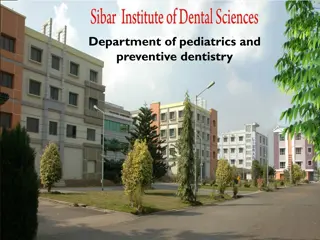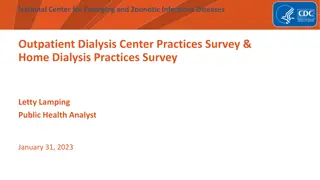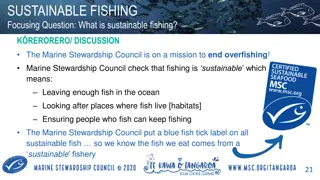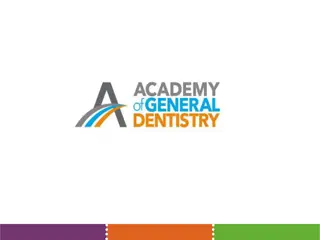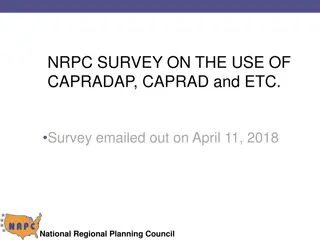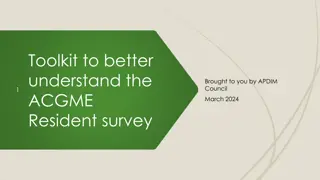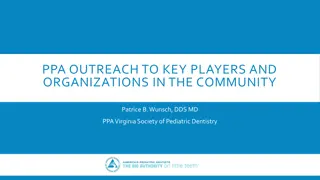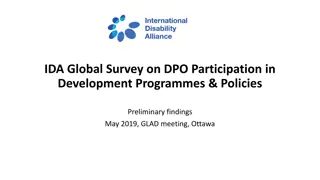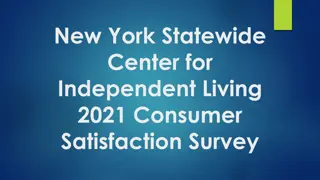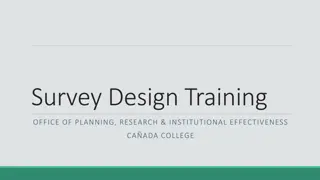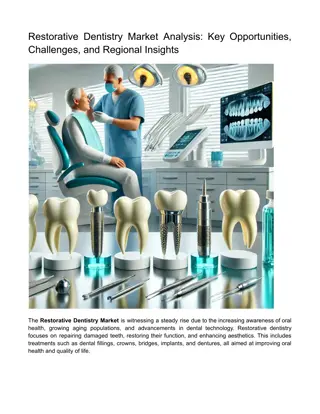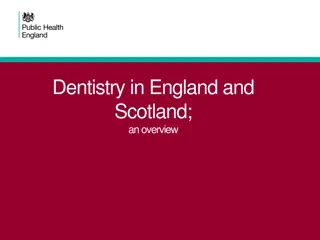Understanding Sustainable Dentistry Practices: Global Survey Insights
A survey conducted in July 2022 by the International Federation of Dental Hygienists (IFDH) aimed to understand dental hygienists' practices and beliefs regarding sustainable dentistry. Insights from 295 respondents across 24 countries highlighted varying levels of familiarity with sustainable dentistry concepts and key elements associated with it, such as reducing plastic use, overall waste, and environmental footprint. The survey delved into the importance of environmentally-friendly practices in dental care and outlined strategies for reducing the environmental impact within dental practices.
Download Presentation

Please find below an Image/Link to download the presentation.
The content on the website is provided AS IS for your information and personal use only. It may not be sold, licensed, or shared on other websites without obtaining consent from the author. Download presentation by click this link. If you encounter any issues during the download, it is possible that the publisher has removed the file from their server.
E N D
Presentation Transcript
Business Use IFDH Sustainable Dentistry Survey July 2022
Business Use Survey Background Survey #7 in a series supported by Procter & Gamble conducted in June/July 2022. Objectives: To better understand global dental hygienists practices and beliefs on SUSTAINABLE DENTISTRY to help develop materials and programs on this topic. Survey flow: IFDH 34 national associations individual members.
Business Use 295 respondents from 24 countries Top countries Canada USA Portugal Korea Switzerland South Africa Finland Spain 19% 15% 9% 8% 8% 7% 6% 4% Countries with < 3% : Belgium, UK, Czech Republic, Australia, New Zealand, Netherlands, Israel, Lithuania, Norway, Sweden, Germany, India, Ireland, Japan, Malta, United Arab Emirates
Business Use How familiar are you with the concept of sustainable How familiar are you with the concept of sustainable dentistry ? dentistry ? Familiarity with sustainable dentistry concept 40% 34.2% 35% 30% 22% are extremely or very familiar 26% 25% 44% are only a little or not at all familiar 20% 17.6% 15.3% 15% 10% 7.1% . 5% 0% Extremely familiar Very familiar Somewhat familiar A little familiar Not at all familiar N=295
Business Use Which elements below do you associate with sustainable dentistry? (Check all Which elements below do you associate with sustainable dentistry? (Check all that apply) that apply) For the purpose of this survey, environmentally For the purpose of this survey, environmentally- -friendly should be understood as "with a low/lower environmental footprint." low/lower environmental footprint." friendly should be understood as "with a % of respondents Attribute (% of respondents 65% or more Reducing use of plastic in the practice (80%) Reducing overall waste in the practice (77%) Using environmentally-friendly products in the practice (76%) Using environmentally-friendly equipment (71%) Reducing single-use disposables in the practice (69%) Reducing use of paper in the practice (68%) Reducing chemical waste in the practice (65%) 59% -64% Improving energy efficiency in the practice (62%) Focusing on preventive care (61%) Recommending environmentally-friendly home care products (60%) Reducing mercury production in dentistry (59%) Less than 59% Reducing emissions from the dental practice (48%) Reducing water use in the practice (45%) Reducing travel to the practice (e.g., treating family members at one time) (43%) Increasing teledentistry appointments (27%) N=219; excludes respondents who selected not at all familiar with concept
Business Use For the purpose of this survey, we will define sustainable dentistry as For the purpose of this survey, we will define sustainable dentistry as reducing the environmental impact in the practice of dentistry while reducing the environmental impact in the practice of dentistry while ensuring infection control and good oral health outcomes. With this ensuring infection control and good oral health outcomes. With this definition in mind, how important is sustainable dentistry to you personally? definition in mind, how important is sustainable dentistry to you personally? How important is sustainable dentistry to you (after reading definition)? 45% 42.0% 41.7% 40% 35% 30% 25% 84% say it s extremely or very important 20% 13.2% 15% 10% 3.1% 5% 0.0% 0% Extremely important Very Somewhat important A little important Not at all important important N=295
Select up to 5 elements that you consider to be extremely important to achieve sustainable dentistry. Business Use % of respondents who selected in Top 5 Attribute Reducing use of plastic in the practice (65%) Reducing overall waste in the practice (62%) Reducing single-use disposables in the practice (52%) Using environmentally-friendly products in the practice (41%) 41% to 65% Focusing on preventive care (40%) Reducing chemical waste in the practice (39%) Reducing use of paper in the practice (32%) Using environmentally-friendly equipment (27%) Improving energy efficiency in the practice (26%) Recommending environmentally-friendly home care products (25%) Reducing mercury production in dentistry (23%) 23% to 40% Reducing water use in the practice (13%) Reducing emissions from the dental practice (11%) Reducing travel to the practice (e.g., treating family members at one time) (9%) Increasing teledentistry appointments (6%) Less than 23% N=295
Business Use Which of the following actions, if any, has the primary dental practice you work in made specifically to improve the sustainability of the practice? (Check all that apply) % of respondents Attribute Increased focus on preventive care (40%) Reduced use of paper in the practice (36%) Used more digital patient education material vs pamphlets (33%) Reduced use of plastic in the practice (30%) Reduced mercury use (29%) Reduced overall waste from the practice (27%) Reduced single-use disposables in the practice (24%) Used more environmentally-friendly products in the practice (24%) 24% to 40% Recommended more environmentally-friendly home care (19%) Reduced travel to the practice (e.g., treating family member at same time) (18%) None, we have not made changes to improve sustainability (18%) Improved energy efficiency in the practice (17%) Used more environmentally-friendly equipment (15%) Reduced chemical waste in the practice (15%) Changed product suppliers to one that is committed to sustainability (12%) Reduced water use in the practice (12%) Increased teledentistry appointments (9%) Reduced emissions from the dental practice (7%) Less than 24% N=295
Business Use Thinking of oral hygiene products you recommend for home care use, how important is it that Thinking of oral hygiene products you recommend for home care use, how important is it that the product be environmentally friendly in order for you to recommend it? the product be environmentally friendly in order for you to recommend it? 40% 37.3% 35% 46% say it s extremely or very important that a product they recommend is environmentally-friendly 29.2% 30% 25% 20% 16.6% 15% 8.8% 10% 8.1% 5% 0% Extremely important Very important Somewhat important A little important Not at all important N=295
Business Use When you think of a product that is environmentally-friendly , select up to 5 product attributes that you consider to be extremely important. % of respondents who selected in Top 5 Attribute Product is effective in maintaining oral health (52%) Product has minimal packaging (51%) Packaging is recyclable (48%) Ingredients are safe for the environment (44%) Product components are biodegradable (43%) Product is recyclable (41%) 41% to 52% Product is made from recyclable material (32%) Product packaging is made from recyclable material (30%) Package is reusable/refillable (30%) Manufacturing process follows sustainability principles (27%) 27% to 40% Ingredients are natural (17%) Non-essential ingredients (e.g., binders, fillers,) are eliminated from the product (16%) Manufacturer of product is leader in sustainability (11%) Product use requires little to no water (5%) Less than 27% N=295
Business Use Please select up to 3 items that you consider to be the BIGGEST challenges to increase sustainability in dentistry? Financial cost 62.0% Limited selection of environmentally-friendly Limited selection of environmentally-friendly products 59.0% and equipment Requires habit change 39.0% Lack of information/direction 38.6% Getting commitment from practice owners 35.3% Getting commitment from the dental team 23.1% Lack of time 11.2% Other, please specify 2.0% None, I don't see any challenges 1.7% N=295
Business Use How strongly do you agree or disagree with the following statements? Top 2 Box Bottom 2 Box Dental hygienists have a responsibility to contribute to sustainability in dentistry. 88% 3% I need more help and education from manufacturers about sustainable dentistry. 87% 5% Preventive oral care plays a role in reducing emissions. 77% 4% Dental hygienists should take the lead towards sustainability in dentistry. 70% 4% My individual actions have a significant impact on achieving sustainable dentistry. 70% 11% Product effectiveness is more important to me than how environmentally-friendly a product is when I make recommendations. 67% 14% If the practice owner is not committed to sustainable dentistry, there is little the dental team can do to achieve it. 61% 26% I am more concerned about the overall environmental impact of the product (including carbon neutral manufacturing) than about the product itself being recyclable. 53% 11% I favor environmentally-friendly products when I make recommendation to patients. 53% 20% Manufacturers are taking action to help dental professionals achieve sustainable dentistry. 40% 30% Dental hygiene associations are taking action to help dental professionals achieve sustainable dentistry. 31% 31% I have enough information about sustainable dentistry to take action. 30% 56% There is sufficient published safety and efficacy data supporting environmentally-friendly products. 20% 40% N=295; Top 2 box = Strongly or somewhat agree. Bottom 2 box = Somewhat or strongly disagree
Business Use Are you aware of the FDI s Sustainability in Dentistry statement? 80% 74.9% 70% 75% are not aware of FDI s Sustainability in Dentistry statement 60% 50% 40% 30% 17.6% 20% 7.5% 10% 0% Yes, I have read the statement. Yes, I have heard of the statement, but I have not read it. No, I am not aware of it. N=295
Business Use How interested are you in learning more about it? 40.% 34.1% 35.% 51% are extremely/very interested in learning more about it 29.3% 30.% 27.5% 25.% 20.% 15.% 10.% 7.7% 5.% 1.5% 0.% Extremely interested Very interested Somewhat interested A little interested Not at all interested N=273; respondents who have read it were excluded.
Business Use Demographics 38% 40.% 35.% Years of dental hygiene experience 30.% 26% 25.% 19% 20.% 17% 15.% 10.% Skewed towards 25 years of experience or more 5.% 0.% Less than 5 years 5 to 15 years 16 to 25 years More than 25 years N=295
Business Use Other, please specify 2% Work Setting Independent Dental Hygienist/Hygiene Practice 13% Community/Public Health 12% 59% are in a private practice setting. Hospital Clinic 2% 13% are in independent dental hygiene practices. Educational Setting 8% Corporate Practice 3% Private Practice, Specialist 11% Private Practice, General Dentistry 48% 0.% 10.% 20.% 30.% 40.% 50.% 60.% N=295
Business Use Which of the following descriptors BEST describes your primary practice setting? Doctoral Degree 5% Master's Degree 16% Education Bachelor's Degree 39% Associate Degree 7% 59% have Bachelor s Degree or Diploma Advanced Diploma 9% Diploma 20% Certificate of Competence 4% 0.% 10.% 20.% 30.% 40.% 50.% N=295
Business Use Break-outs by Region The following slides highlight key differences by region, specifically North America, Europe, and Rest of World (Asia, Africa, Middle East, Oceania). Statistical testing has not been conducted, so consider these as numerical trends. 24% Rest of World Europe North America 34% 42% For questions that have numerous potential responses, only those responses with large differences (~10%) across regions are shown.
Business Use How familiar are you with the concept of sustainable How familiar are you with the concept of sustainable dentistry ? dentistry ? 45% North American respondents indicate less familiarity with the concept of sustainable dentistry versus those from the Europe and other regions. Rest of World Europe North America 40% 35% 30% 25% 20% 15% 10% 5% 0% Extremely familiar Very familiar Somewhat familiar A little familiar Not at all familiar
Business Use Which of the following actions, if any, has the primary dental practice you work in made specifically to improve the sustainability of the practice? (Check all that apply) North America Europe Rest of World None, we have not made changes to improve sustainability In general, respondents from North America indicate their practice has taken fewer action steps towards sustainability versus respondents from other regions. Increased focus on preventive care Reduced overall waste from the practice Reduced travel to the practice (e.g., treating family member at same time) Reduced mercury use Reduced single-use disposables in the practice Improved energy efficiency in the practice Reduced use of plastic in the practice Recommended more environmentally-friendly home care 0% 10% 20% 30% 40% 50% N=295
Business Use Thinking of oral hygiene products you recommend for home Thinking of oral hygiene products you recommend for home care use, how important is it that the product be care use, how important is it that the product be environmentally friendly in order for you to recommend it? environmentally friendly in order for you to recommend it? North American respondents place less importance on a product being environmentally friendly to recommend it compared to respondents from other regions. 50% Rest of World Europe North America 45% 40% 35% 30% 25% 20% 15% 10% 5% 0% Extremely important Very Somewhat important A little important Not at all important important
Business Use When you think of a product that is environmentally-friendly , select up to 5 product attributes that you consider to be extremely important. North America Europe Rest of World A higher percentage of North American respondents versus those from other regions think it s extremely important for environmentally-friendly products to be effective, have minimal/recyclable packaging, and ingredients that are safe for the environment. 61% Product is effective in maintaining oral health 52% 44% 48% Product components are biodegradable 36% 49% 59% Product has minimal packaging 46% 49% 54% Ingredients are safe for the environment 38% 42% Note, there are stricter regulations around sustainable packaging materials and ingredient safety for the environment in some regions outside North America, so those attributes may be expected for all products by respondents. 24% Product is made from recyclable material 40% 28% Non-essential ingredients (e.g., binders, fillers, stabilizers, preservatives) are eliminated from the 16% 20% 7% 23% Package is reusable/refillable 30% 38% 55% Packaging is recyclable 38% 51% 0% 10% 20% 30% 40% 50% 60% 70%
Business Use Please select up to 3 items that you consider to be the BIGGEST challenges to increase sustainability in dentistry? Financial cost , limited selection of environmentally- friendly products and equipment , and practice owner commitment are rated as bigger barriers in North America than other regions. North America Europe Rest of World 67% Limited selection of environmentally-friendly products and equipment 57% 54% 18% Getting commitment from the dental team 20% 35% Getting commitment from the dental team is a rated as a bigger barrier outside of Europe and North America. 70% Financial cost 59% 58% 33% Requires habit change 43% 38% 42% Getting commitment from practice owners 30% 31% 0% 20% 40% 60% 80%
Business Use How strongly do you agree or disagree with the following statements? % below indicates STRONGLY or SOMEWHAT agree. North America Europe Rest of World 68% Dental hygienists should take the lead towards sustainability in dentistry. 63% 85% I am more concerned about the overall environmental impact of the product (including carbon neutral manufacturing) than about the product itself being recyclable. 46% In general, respondents from North America believe there is less engagement from manufacturers and dental hygiene associations regarding sustainable dentistry than those in other regions. North Americans also place more importance on product effectiveness than the product being environmentally-friendly. 50% 64% 28% Manufacturers are taking action to help achieve dental professionals sustainable dentistry. 50% 43% Dental hygiene associations are taking action to help dental professionals achieve sustainable dentistry. 23% 34% 40% 69% Preventive oral care plays a role in reducing emissions. 79% 81% Product effectiveness is more important to me than how environmentally-friendly a product is when I make recommendations. 75% 62% 65% 0% 20% 40% 60% 80% 100%
Business Use Are you aware of the FDI s Sustainability in Dentistry statement? 100% Rest of World Europe North America 88% 90% 80% 74% Awareness of the FDI s Sustainability in Dentistry statement is lowest in North America, although awareness is low across all regions. 70% 63% 60% 50% 40% 30% 25% 18% 20% 13% 10% 9% 10% 2% 0% Yes, I have read the statement. Yes, I have heard of the statement, but I have not read it. No, I am not aware of it. N=295
Business Use How many years have you been working as a dental hygienist, dental therapist or oral health therapist? 60% Respondents from Europe skewed towards less experience while those from Rest of World and North America skewed towards more experience. Rest of World Europe North America 49% 50% 40% 40% 32% 30% 30% Based on this analysis and other sustainability trend sources, differences in responses seem to be related to region of residence rather than years of experience, which is presumed to correspond with age. 26% 26% 22% 21% 20% 16% 14% 13% 11% 10% 0% Less than 5 years 5 to 15 years 16 to 25 years More than 25 years
Business Use Which of the following descriptors BEST describes your primary practice setting? A higher percentage of respondents from Europe practice in an independent hygiene practice or community/public health setting than those from other regions. 70% Rest of World Europe North America 62% 60% 50% 46% A higher percentage of respondents from North America practice in a general private practice setting. 40% 38% 30% 20% 19% 20% 18% 15% A higher percentage of respondents from outside Europe and North America practice in a specialty private practice or educational setting. 12% 10% 10% 8% 7% 6% 6% 6% 4% 0% Private Practice, General Dentistry Private Practice, Specialist Educational Setting Community/Public Independent Dental Hygienist/Hygiene Practice Health
Business Use Other IFDH Survey Results Click the links below to learn more about other IFDH surveys: 2022 Elderly Patient Survey 2021 Pediatric Patient Survey 2021 Oral-systemic link survey 2020 Electric toothbrush survey 2020 Covid Survey 2019 Toothpaste Survey The IFDH thanks Procter & Gamble for supporting these surveys.







